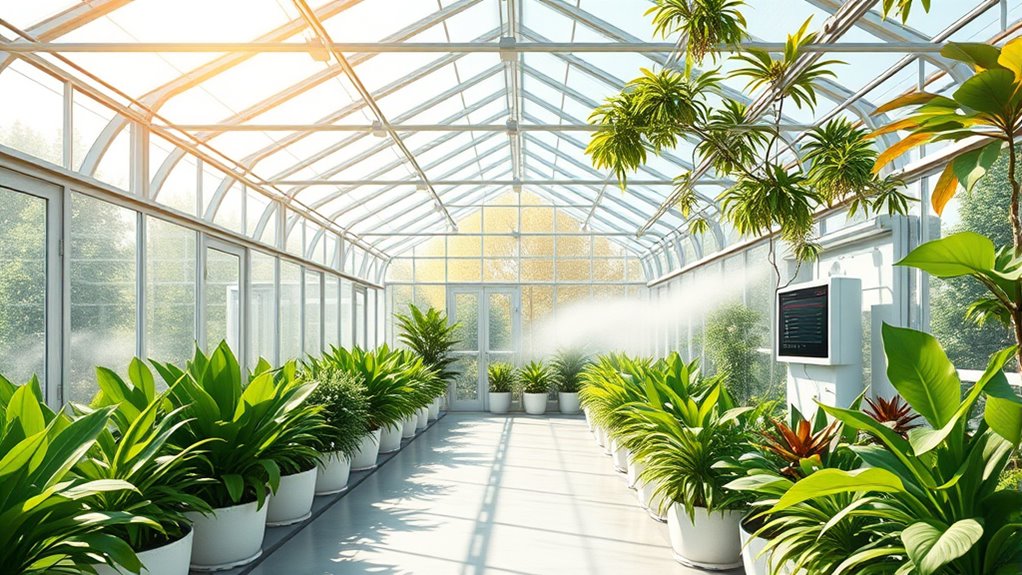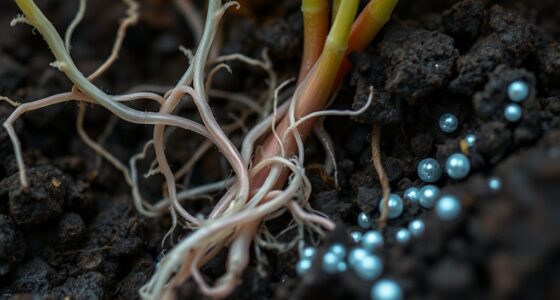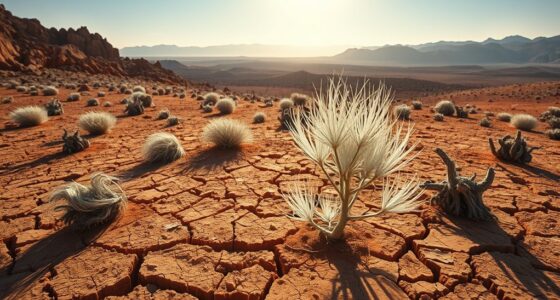To manage your greenhouse climate during peak summer, guarantee proper ventilation by regularly opening exhaust fans and roof vents to release excess heat and humidity. Use intake vents to bring in cooler, drier air and consider humidifiers or dehumidifiers based on real-time sensor feedback. Adjust fans and vents during the hottest parts of the day, and monitor conditions closely to keep temperature and humidity within ideal ranges for your rare species. Discover more strategies to maintain perfect conditions and protect your plants effectively.
Key Takeaways
- Install automated exhaust fans and roof vents to regulate temperature during peak heat hours.
- Use intake vents to bring in cooler, drier outdoor air and promote steady airflow.
- Monitor temperature and humidity with reliable sensors and adjust ventilation accordingly.
- Employ dehumidifiers to control excess moisture and prevent fungal growth.
- Combine ventilation with humidity management techniques to maintain stable, optimal conditions for rare species.

During peak summer, managing the greenhouse climate for rare species becomes crucial to guarantee their survival and health. High temperatures and humidity levels can quickly become detrimental if not carefully controlled. To achieve this, you need effective ventilation strategies that promote air circulation, prevent heat buildup, and guarantee fresh air exchange. Proper ventilation helps remove excess heat and moisture, reducing the risk of fungal diseases and stress on delicate plants. You should consider installing exhaust fans and roof vents that open automatically when temperatures rise beyond set thresholds. Pairing these with intake vents allows a steady flow of cooler, drier air, creating a balanced environment. Regularly inspecting and adjusting vent settings ensures ideal airflow, especially during the hottest parts of the day.
Effective summer ventilation prevents heat buildup and maintains healthy conditions for rare plants.
Humidity control plays a critical role in maintaining the delicate balance necessary for rare species. Excess humidity can foster mold and rot, while too little can cause dehydration and stress. To manage humidity effectively, you should use a combination of dehumidifiers, misting systems, and ventilation. Dehumidifiers are particularly useful in reducing moisture levels during peak heat, preventing the conditions that promote fungal growth. Conversely, misting can help raise humidity when it drops too low, but it must be used cautiously to avoid increasing humidity excessively. Ventilation complements humidity control by exchanging moist indoor air with drier outside air, especially during cooler parts of the day or when outdoor conditions are favorable. Additionally, utilizing industry-standard sensors ensures accurate environmental monitoring, enabling timely adjustments to maintain optimal conditions.
It’s essential to monitor environmental parameters closely with reliable sensors that provide real-time data on temperature and humidity. This enables you to respond quickly, adjusting fans, vents, or humidifying devices as needed. During the hottest hours, you might need to increase ventilation efforts to keep the temperature below critical thresholds, while also balancing humidity to prevent condensation. Conversely, early mornings or cooler evenings may require less active intervention, allowing the greenhouse to stabilize naturally.
Ultimately, integrating well-planned ventilation strategies with precise humidity control creates a stable and safe environment for your rare species. This approach minimizes stress, reduces disease risk, and promotes healthy growth during peak summer conditions. Staying vigilant and adapting your climate management techniques ensures your greenhouse remains a sanctuary for these sensitive plants, even when outside temperatures soar.
Frequently Asked Questions
How Can I Monitor Greenhouse Climate Remotely During Peak Summer?
To monitor your greenhouse climate remotely, you should use connected sensors with regular calibration to guarantee accuracy. Set up data logging devices that record temperature, humidity, and CO2 levels continuously. You can access this data via a smartphone app or web portal, allowing you to track conditions in real-time during peak summer. This setup helps you respond quickly to any climate fluctuations, maintaining ideal conditions for your plants.
What Are the Best Cooling Systems for Maintaining Constant Temperature?
Imagine your greenhouse turning into a summer sauna—hot enough to melt your patience. To prevent this, you should consider passive cooling methods like shading and ventilation, which work without electricity. Evaporative cooling systems, like misters and swamp coolers, also work wonders by drawing in dry air and cooling it naturally. These options help you keep a steady temperature, ensuring your rare species thrive instead of sweat through their leaves.
How Do Humidity Levels Affect Rare Species in Summer?
Humidity levels play a vital role in the health of rare species during summer. Proper humidity control helps prevent stress caused by excessive dryness or dampness. You should monitor and adjust humidity to support plant transpiration, ensuring plants can absorb nutrients efficiently without dehydration. Maintaining ideal humidity levels promotes stable conditions, reduces disease risk, and keeps your rare species thriving through the heat.
Can Natural Ventilation Effectively Regulate Greenhouse Climate in Extreme Heat?
Think of natural ventilation as a gentle breeze that can cool a greenhouse like a gust of fresh air. In extreme heat, natural airflow offers a form of passive cooling, helping regulate temperature without mechanical systems. While it can be effective, its success depends on external conditions like wind and humidity. You might need supplemental shading or fans during the hottest days to guarantee the climate stays suitable for your rare species.
What Emergency Measures Should Be in Place for Heatwaves?
You should prioritize emergency preparedness to handle heatwaves effectively. Implement heat stress mitigation strategies like installing backup cooling systems, increasing shade, and ensuring adequate hydration. Develop clear protocols for rapid response, including monitoring temperature spikes and evacuating vulnerable species if needed. Regularly train staff on emergency procedures, so everyone stays alert and ready. These measures help safeguard your greenhouse during extreme heat, protecting both plants and staff.
Conclusion
As you gently fine-tune your greenhouse environment, you create a welcoming haven where rare species can flourish even during the warmest days. Your careful adjustments and attentive care act as subtle whispers of comfort, ensuring these delicate creatures thrive quietly beneath your watch. In nurturing their habitat, you foster a silent partnership, allowing nature’s hidden treasures to blossom softly. With each thoughtful step, you’re helping preserve the beauty of these exceptional species for generations to come.










